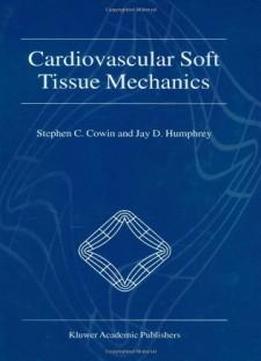
Cardiovascular Soft Tissue Mechanics
by Stephen C. Cowin /
2002 / English / PDF
10 MB Download
The seven papers of this volume present a glimpse into current
research on soft tissue mechanics as well as some future
directions. The seven papers concern tissues within the
cardiovascular system: three focus on arteries, three on the heart,
and one on biaxial testing of planar tissues such as heart valves.
Given that cardiovascular disease continues to be the leading cause
of death in the developed world, the importance of such research is
clear. There are notable common features of the seven papers.
First, most of the proposed constitutive relations are motivated
directly by data on the underlying microstructure, and especially
the orientations of a structurally important protein (collagen)
that forms as undulated cross-linked fibers. Another feature of
most of the papers is the consideration of the fact that both
arteries and the heart contain muscle and that there is a need to
quantify the so-called active (contractile) response in addition to
the passive (non-contractile) response. Such relations must not
only be structurally motivated, they must ultimately include the
kinetics of calcium transport in the muscle. Constitutive relations
for active behavior are discussed in the majority of the papers.
The growth and remodeling of cardiovascular tissues is another
common feature of the papers. Over the last twenty years, separate
advances in biochemistry, cell biology, genetic engineering, and
biomechanics have focused attention on the ubiquitous role of
growth and remodeling of tissues.
The seven papers of this volume present a glimpse into current
research on soft tissue mechanics as well as some future
directions. The seven papers concern tissues within the
cardiovascular system: three focus on arteries, three on the heart,
and one on biaxial testing of planar tissues such as heart valves.
Given that cardiovascular disease continues to be the leading cause
of death in the developed world, the importance of such research is
clear. There are notable common features of the seven papers.
First, most of the proposed constitutive relations are motivated
directly by data on the underlying microstructure, and especially
the orientations of a structurally important protein (collagen)
that forms as undulated cross-linked fibers. Another feature of
most of the papers is the consideration of the fact that both
arteries and the heart contain muscle and that there is a need to
quantify the so-called active (contractile) response in addition to
the passive (non-contractile) response. Such relations must not
only be structurally motivated, they must ultimately include the
kinetics of calcium transport in the muscle. Constitutive relations
for active behavior are discussed in the majority of the papers.
The growth and remodeling of cardiovascular tissues is another
common feature of the papers. Over the last twenty years, separate
advances in biochemistry, cell biology, genetic engineering, and
biomechanics have focused attention on the ubiquitous role of
growth and remodeling of tissues.











